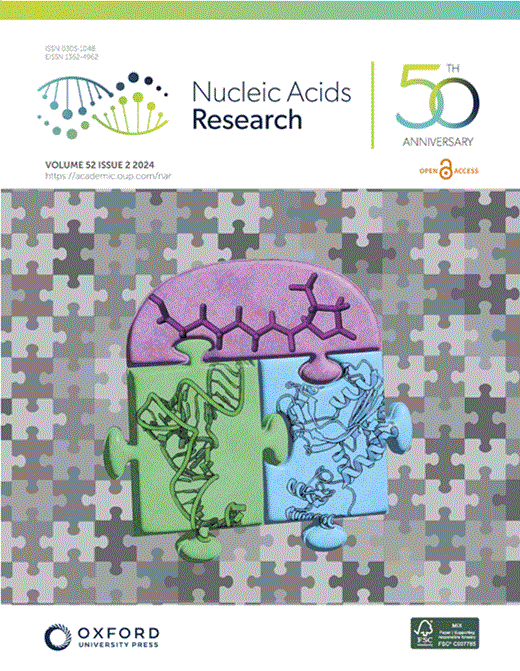Tiny but multi-stable: four distinct conformational states govern the ligand-free state of the preQ1 riboswitch from a thermophilic bacterium
IF 16.6
2区 生物学
Q1 BIOCHEMISTRY & MOLECULAR BIOLOGY
引用次数: 0
Abstract
Translational riboswitches are bacterial gene regulatory elements located in the 5′-untranslated region of mRNAs. They operate through a conformational refolding reaction that is triggered by a change in concentration of a modulating small molecule ligand. The initially model posited that the two functional states, the ligand-bound and ligand-free state, would only populate two stable conformations. However, the subsequent discoveries of multiple conformations for the apo- and holo-states of riboswitches have rendered this model obsolete. Concomitantly, a comprehensive account of the conformational multistability of riboswitches has remained elusive. In this study, we demonstrate that even the smallest naturally occurring translational riboswitch, the preQ1-sensing riboswitch from Thermoanaerobacter tengcongensis, adopts four distinct and structurally different conformations in the absence of ligand. This is in contrast to structures determined by X-ray crystallography, which reveal only minor deviations between the ligand-free and ligand-bound states. Utilizing NMR-spectroscopic analysis, we characterize the structurally heterogeneous apo-state and depict four distinct conformations that demonstrate varying temperature stabilities. Upon ligand-binding, the folding pathway undergoes kinetic partitioning, thereby enabling regulatory plasticity to integrate multiple environmental inputs for riboswitch-based gene regulation.微小但多稳定:嗜热细菌的preQ1核糖开关的无配体状态由四种不同的构象状态控制
翻译核糖开关是细菌基因调控元件,位于mrna的5 ' -非翻译区。它们通过由调节小分子配体的浓度变化引发的构象再折叠反应起作用。最初的模型假设两种功能态,配体结合态和配体自由态,只会形成两种稳定的构象。然而,随后发现的多种构象的载脂蛋白和全息状态的核开关已经使这个模型过时。与此同时,对核糖开关构象多稳定性的全面描述仍然难以捉摸。在这项研究中,我们证明了即使是最小的自然存在的翻译核糖开关,来自热厌氧菌tengcongensis的预q1感应核糖开关,在没有配体的情况下也会采用四种不同的结构不同的构象。这与x射线晶体学测定的结构相反,x射线晶体学只揭示了无配体和配体结合态之间的微小偏差。利用核磁共振光谱分析,我们表征了结构上不均匀的载脂蛋白状态,并描绘了四种不同的构象,表现出不同的温度稳定性。在配体结合后,折叠途径进行动力学分配,从而使调控可塑性能够整合多种环境输入以进行基于核糖体开关的基因调控。
本文章由计算机程序翻译,如有差异,请以英文原文为准。
求助全文
约1分钟内获得全文
求助全文
来源期刊

Nucleic Acids Research
生物-生化与分子生物学
CiteScore
27.10
自引率
4.70%
发文量
1057
审稿时长
2 months
期刊介绍:
Nucleic Acids Research (NAR) is a scientific journal that publishes research on various aspects of nucleic acids and proteins involved in nucleic acid metabolism and interactions. It covers areas such as chemistry and synthetic biology, computational biology, gene regulation, chromatin and epigenetics, genome integrity, repair and replication, genomics, molecular biology, nucleic acid enzymes, RNA, and structural biology. The journal also includes a Survey and Summary section for brief reviews. Additionally, each year, the first issue is dedicated to biological databases, and an issue in July focuses on web-based software resources for the biological community. Nucleic Acids Research is indexed by several services including Abstracts on Hygiene and Communicable Diseases, Animal Breeding Abstracts, Agricultural Engineering Abstracts, Agbiotech News and Information, BIOSIS Previews, CAB Abstracts, and EMBASE.
 求助内容:
求助内容: 应助结果提醒方式:
应助结果提醒方式:


